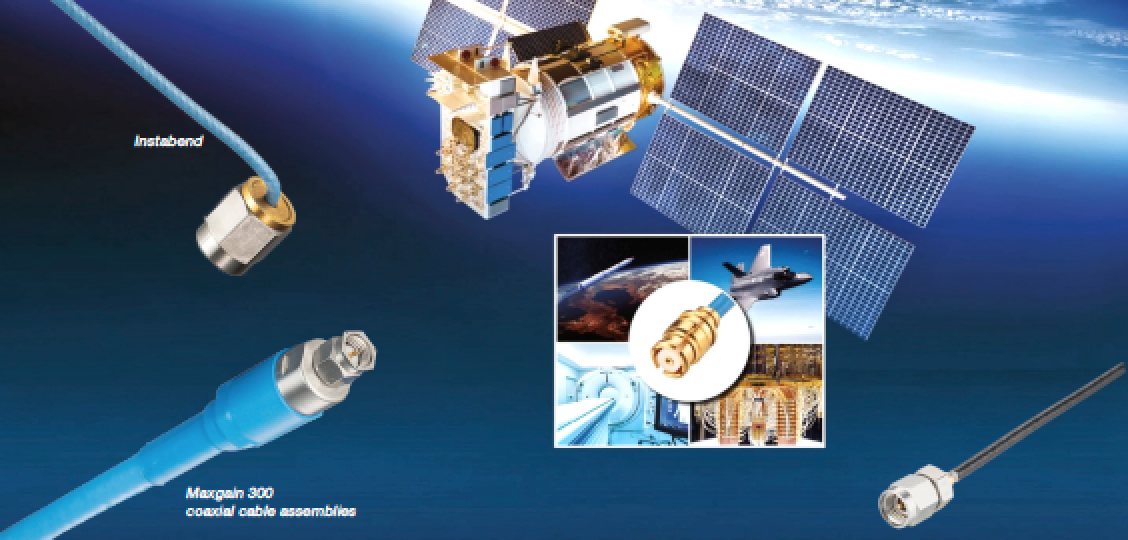The growth of satellite applications has created a period of rapid development in the commercial space industry. For example, there is a growing need for smaller-sized low-earth orbit (LEO) satellites operating at higher frequencies to meet swiftly increasing bandwidth requirements. These satellites travel at high speeds around the Earth at lower altitudes, unlike the larger GEO (Geostationary Orbit) satellites used by government agencies like NASA.

LEO satellites cover a smaller area of the Earth’s surface. This results in a shorter communication latency, making them a perfect fit for applications that require real-time data transmission and global coverage. Commercial entities, such as Amazon and SpaceX, are launching constellations of LEO satellites to provide global broadband internet coverage, which requires thousands of satellites to be launched into orbit in a sequential manner to ensure consistent and comprehensive coverage.
The RF cable assemblies used in LEO satellites play a crucial role in achieving fast, reliable communication and high-performance operations; they act as the vital bridge between many critical systems, including communications, signal transport, payload, and processing.
However, traditional semi-rigid RF cable technology is often unsuitable for use in small satellites—where space constraints are significant—because of routing limitations and the need for flexibility during installation. Furthermore, the extreme environmental conditions of space present unique challenges.
That’s why it’s essential to consider a range of material selection factors when choosing a coaxial cable assembly for LEO satellites, including shielding effectiveness, radiation resistance, whiskering, and outgassing, in addition to evaluating cable performance parameters such as attenuation, phase stability over temperature, and stability over flexure.
Material Considerations
The materials used within the RF cable significantly impact its performance. For example, cable assemblies for small satellite applications can be subjected to 30 Mrads of radiation and temperatures ranging from -90°C to 150°C. Therefore, it’s crucial to consider whether the materials used within the cable can withstand extreme conditions. Several important factors must be considered to ensure optimal performance.
Shielding Effectiveness
Electromagnetic interference (EMI) is an undesirable phenomenon when an outside signal or source causes a disturbance. Without effective shielding to prevent EMI, cable assemblies would have to be kept a greater distance apart to avoid it, which isn’t possible in small, densely packed systems such as LEO satellites. Cables constructed using internal multiple shields are optimal for mitigating EMI.
Radiation Resistance
Radiation exposure can change the cable dielectric and degrade electrical performance. The cable location within the system determines how much radiation it will be exposed to.
Depending on construction, cables will be rated to withstand varying amounts of radiation. System designers must carefully mitigate radiation exposure within the satellite by using metal shields to keep components, including RF cables, below the total exposure limits.

However, critical cables sometimes may have to be routed to remote locations. For example, RF cables exiting the safety of the bus to reach a remote antenna will be exposed to increasing amounts of radiation. They must be protected or constructed using materials that will be affected less than plastic polymers.
Whiskering
Tin is a commonly used material in solders for coaxial connector terminations. However, metals such as pure tin can grow whiskers in high-temperature and vacuum environments and are generally prohibited from use in spaceflight applications as a result. Coaxial cable assemblies must be built with tin/lead solder alloys to avoid whiskering. For LEO applications, smaller diameter RF cable assemblies minimize the number of solder joints and are designed to fit in tight spaces.
Outgassing
Many non-metallic materials outgas when exposed to a vacuum environment. This includes plastics such as PTFE, PVC, and PE, commonly used in coaxial cables. Emitted gases can recondense on critical components and degrade performance. Therefore, materials for cable assemblies traveling into space must meet industry standards for low outgassing.
Cable Performance
Maintaining cable performance once an assembly is installed is essential for the function of a LEO satellite. Three crucial parameters that influence cable performance include attenuation, phase stability, and stability over flexure.
Attenuation
The three properties that define the attenuation of a coaxial cable include its diameter, the conductivity of the conductors, and the dielectric constant.
Larger-diameter cables provide lower attenuation per unit length than comparable smaller-diameter cables, but this comes along with increased weight and a wider minimum bend radius. Larger cables cannot be bent as tightly as that will cause the cable to kink or become oblong, causing an impedance mismatch and excessive return loss.
High-conductivity materials such as silver and copper also provide low attenuation per unit length but are often heavy or expensive. Lighter-weight materials such as aluminum and stainless steel reduce overall mass but are poor conductors. Cable manufacturers frequently optimize conductor designs by plating or cladding a low-cost, lightweight base metal with higher-conductivity copper or silver for the RF path.
Finally, a lower-loss dielectric generally will be lighter because it incorporates more air. More air in the dielectric materials lowers the effective dielectric constant, meaning the transmitted signal encounters less resistance or loss, making performance closer to the ideal of a wave traveling in a vacuum.
Phase Stability
Polytetrafluoroethylene (PTFE) and TF4® dielectric cables are fit for smaller satellite applications in space but each has its place, depending on the specific use case. PTFE has a high melting point and excellent dielectric properties, making it popular in many microwave applications. However, at about 19°C, PTFE exhibits a non-linear change in phase known as the “knee.”
This change is problematic for applications where phase stability is crucial. Proprietary fluorocarbon dielectrics such as TF4® can mitigate the phase stability over temperature issues created by using PTFE by eliminating the non- linear phase performance that occurs between 15 and 25°C.
Stability Over Flexure
In tight or in-the-box spaces, cable flexibility is crucial for routing. However, a flexible cable must maintain stable performance over flexure.
RF Cable Assembly Innovations For Smallsats
LEO satellite applications are drastically different from their GEO counterparts from a design perspective. One key difference is the need for faster development, which means readily available cable assemblies are necessary for rapid product development and testing. Once testing is complete, these solutions should be easily customizable to meet the unique needs of different applications.
Additionally, traditional, semi-rigid RF cable technology is often not suitable for the significant space constraints of smaller LEO satellites due to routing limitations and the need for flexibility during installation. A new class of flexible RF cable assemblies specifically designed for small satellites and similar applications offers compact and flexible coaxial microwave assemblies.
These innovative solutions can be easily routed through tight spaces without compromising reliability or performance.
These highly flexible cable assemblies can bend closely behind the connector, allowing maximum routing flexibility in small spaces, including interconnects between RF circuit cards, modules, and enclosure panels. The advantage lies in the unique clamp technology, eliminating the need for solder connections traditionally found in larger-diameter cable assemblies. They also offer a comprehensive solution with a triple-shield construction, broad frequency range, and exceptional durability.

This type of cable technology also comes in phase stable assemblies, which are low-loss, ultra-flexible foam-core micro coaxial cables that eliminate the PTFE phase change, making it ideal for applications that require stable phase performance over temperature. Both types are designed to withstand extreme conditions in space and function continuously over a long period.
However, it is essential to note that even though the design methodologies are different, RF assemblies used in smallsat applications are still required to meet the rigors of the space environment, including the considerations outlined above.
Working with a supplier with an extensive heritage in space and other demanding industries, a large manufacturing footprint, and access to the correct materials and technologies is recommended to create the best solution for smallsats.
timesmicrowave.com
Author Maria Calia is the Director of Space and Missiles at Times Microwave Systems. Her expertise includes mechanical engineering, electrical engineering, hardware engineering, project management, conveying systems, RF microwave, and more. Maria earned a Bachelor of Science in mechanical engineering from Drexel University.


